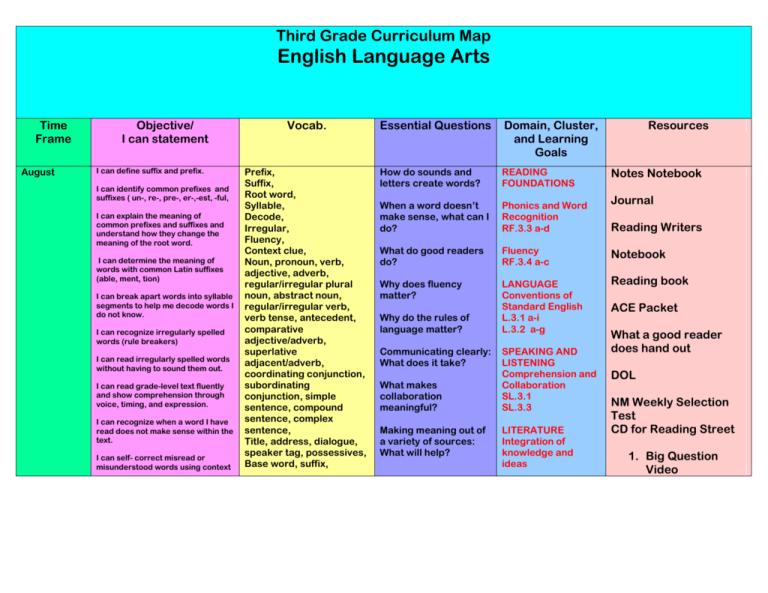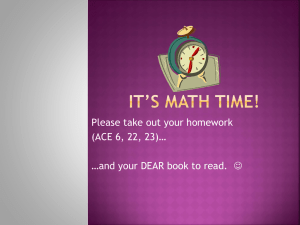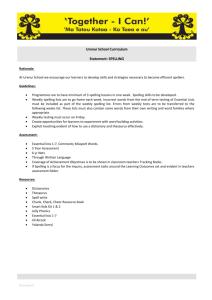Third Grade Curriculum Map
advertisement

Third Grade Curriculum Map English Language Arts Time Frame August Objective/ I can statement I can define suffix and prefix. I can identify common prefixes and suffixes ( un-, re-, pre-, er-,-est, -ful, I can explain the meaning of common prefixes and suffixes and understand how they change the meaning of the root word. I can determine the meaning of words with common Latin suffixes (able, ment, tion) I can break apart words into syllable segments to help me decode words I do not know. I can recognize irregularly spelled words (rule breakers) I can read irregularly spelled words without having to sound them out. I can read grade-level text fluently and show comprehension through voice, timing, and expression. I can recognize when a word I have read does not make sense within the text. I can self- correct misread or misunderstood words using context Vocab. Prefix, Suffix, Root word, Syllable, Decode, Irregular, Fluency, Context clue, Noun, pronoun, verb, adjective, adverb, regular/irregular plural noun, abstract noun, regular/irregular verb, verb tense, antecedent, comparative adjective/adverb, superlative adjacent/adverb, coordinating conjunction, subordinating conjunction, simple sentence, compound sentence, complex sentence, Title, address, dialogue, speaker tag, possessives, Base word, suffix, Essential Questions Domain, Cluster, and Learning Goals How do sounds and letters create words? READING FOUNDATIONS When a word doesn’t make sense, what can I do? Phonics and Word Recognition RF.3.3 a-d What do good readers do? Fluency RF.3.4 a-c Notebook Why does fluency matter? LANGUAGE Conventions of Standard English L.3.1 a-i L.3.2 a-g Reading book Why do the rules of language matter? Communicating clearly: What does it take? What makes collaboration meaningful? Making meaning out of a variety of sources: What will help? SPEAKING AND LISTENING Comprehension and Collaboration SL.3.1 SL.3.3 LITERATURE Integration of knowledge and ideas Resources Notes Notebook Journal Reading Writers ACE Packet What a good reader does hand out DOL NM Weekly Selection Test CD for Reading Street 1. Big Question Video clues. I can reread with corrections when necessary. resource, Discussion, connection, Presentation, detail, elaborate, RL.3.7 2. Grammar Jammer I can read fluently ( easy, smooth, and automatic). WR Reading Skill Builders I can define noun(person, place, thing, idea) and pronoun ( a word that takes place of a noun) and explain how they function in a sentence. Reading Centers Florida Institute I can define verb (an actin or a state of being) and explain how it functions in a sentence. I can define adjective (a word that adds meaning to a noun or pronoun) and adverb ( a word that adds meaning to a verb, adjective or other adverb) and explain how they function in a sentence. I can define plural (more than one) and form/use (boy/boys)regular and irregular plural nouns (mouse/mice) correctly. I can define abstract nouns (nouns that represent an idea, feeling, emotion, etc) and use them correctly. I can explain the difference between regular verbs (walk, walked) and irregular verbs ( run, ran) and form/use them correctly. I can explain the difference between simple verb tenses ( past, present, future) and form/use them correctly. I can define subject and verb and explain that a singular subject needs a singular verb and a plural subject needs a plural verb. Supplemental Level Readers (3 Levels) Decodable Practice Readers Supplemental Spelling/ Old Yellow Spelling book Graphic Organizer for Vocabulary Weekly Readers ACE ** Assessment* Baseline Group Pre Test Fluency Test 2x Month ACE Comprehension Checks/Utilizing Rubric I can define antecedent ( the word or group of words a pronoun replace) and make sure a pronoun agrees with its antecedent. I can identify comparative adjectives/adverbs (formed by adding –er or more) and superlative adjectives/adverbs (formed by adding –est or most ) and choose the correct form when writing or speaking. I can identify coordinating conjunctions (for, and, nor, but, or, yet, so) and subordinating conjunctions ( after, because, if, since, while) and use them correctly. I can identify and create simple sentences, compound sentences, and complex sentences. I can identify words in a title that should be capitalized ( first and last words, nouns, pronouns, verbs, adjectives, subordinating conjunctions , prepositions of five or more letters). I can identify words in a title that should not be capitalized (articles, coordinating conjunctions, prepositions of four or more letters). I can use a comma to separate the city and state in an address. I can punctuate dialogue correctly by using commas before/after speaker tags and placing quotation marks around spoken words. I can define possessives (nouns that own something) and form singular pissessives (add apostrophe s) and plural possessives( add and 1.Think Critically Questions at end of story apostrophe after the existing s) I can spell high-frequency words correctly. I can recognize when I need to double consonants, drop e, or change y to I and adding suffixes to base words. I can write words correctly using common spelling patterns and generalizations. I can identify misspelled words and use resources to assist me in spelling correctly. I can read or study material to be discussed. I can list important information about the topic to be discussed. I can identify and follow the agreed upon rules for discussion. I can ask questions when I do not understand. I can stay on topic by making comments about the information being discussed. I can make connections between the comments of others. I can explain my own ideas and tell what I’ve learned from a discussion. I can ask questions about a speaker’s presentation when I do not understand or need more information. I can answer questions about a speaker’s presentation by using appropriate elaboration and detail. August September I can recount/retell (put into my own words) stories. I can define central message, lesson and /or moral (overall idea an author is trying to share) I can explain the central message, lesson and or moral using key details from the story. I can identify characters in the story. I can describe characters in a story using physical (outside qualities) and emotional ( inside qualities) traits. I can explain how characters’ actions cause events to occur in a certain order/sequence. I can identify illustrations that support the story. I can explain how illustrations contribute (add meaning) to the words in the story. Recount, central message, lesson, moral, key detail, fable, folktale, myth, character, physical traits, emotional traits, action, event, sequence, contribute, What do good readers do? Am I clear about what I just read? How do I know? In what ways does creative choice impact an audience? Whose story is it, and why does it matter? READING LITERATURE/READI NG INFORMATIONAL TEXT Key ideas and Details RL.3.2 RL.3.3 Notes Notebook Journal Reading Writers Notebook Reading book ACE Packet What a good reader does hand out DOL NM Weekly Selection Test CD for Reading Street 1. Big Question Video 2. Grammar Jammer WR Reading Skill Builders Reading Centers Florida Institute Supplemental Level Readers (3 Levels) Decodable Practice Readers Supplemental Spelling/ Old Yellow Spelling book Graphic Organizer for Vocabulary Weekly Readers ACE ** Assessment* Baseline Group Pre Test Fluency Test 2x Month ACE Comprehension Checks/Utilizing Rubric 1.Think Critically Questions at end of story September I can explain how stories , dramas and poems are written in different forms (chapter, scene., stanza). I can use the terms chapter, scene, and or stanza correctly when writing or speaking about parts of a text. I can descrie how chapters, scenes and stanzas give the reader information and work together to create the story, drama or poem. I can locate words and details to answer questions in a text. I can ask and answer questions before, during, and after reading a text. I can identify the writing style (opinion, informative,/explanatory, or narrative) that best fits my task or purpose. I can use graphic organizers to develop my writing ideas. I can create a piece of writing that shows my understanding of a specific writing style. I can identify information from a text being read aloud. I can identify information that is presented in different formats(media, charts, graphs, website, speeches) I can use the information gathered to determine the main idea and support details of a presentation. I can ask questions about a speaker’s presentation when I do not understand or need more information. Story, drama, poem, chapter, scene, stanza, Details, writing style, task, purpose, graphic organizer, Format, main idea, supporting details, Presentation, detail, elaborate, Author’s choice: Why does it matter? What makes a story a great story? What do good readers do? Am I clear about what I just read? How do I know? Writing Clearly: What makes a difference? Final product: What does it take? What makes collaboration meaningful? Making meaning out of a variety of sources: What will help? READING LITERATURE/ INFORMATIONAL TEXT Craft and Structure RL.3.5 Key Ideas and Details RL.3.1 (Mid Sept) Integration of knowledge and ideas RL.3.8???? WRITING Production and distribution of Writing W.3.4 SPEAKING AND LISTENING Comprehension and Collaboration SL.3.2 SL.3.3 Notes Notebook Journal Reading Writers Notebook Reading book ACE Packet What a good reader does hand out DOL NM Weekly Selection Test CD for Reading Street 1. Big Question Video 2. Grammar Jammer WR Reading Skill Builders Reading Centers Florida Institute Supplemental Level Readers (3 Levels) I can answer questions about a speaker’s presentation by using appropriate elaboration and detail. Decodable Practice Readers Supplemental Spelling/ Old Yellow Spelling book Graphic Organizer for Vocabulary Weekly Readers ACE ** Assessment* Baseline Group Pre Test Fluency Test 2x Month ACE Comprehension Checks/Utilizing Rubric 1.Think Critically Questions at end of story October I can use strategies (context clues, root words, affixes) to determine the meaning of words and phrases as they are used in a text. I can define literal language (it says what it means) and nonliteral (what it says is not exactly what it means) Literal language, nonliteral language, context clues, Affix, root, reference material, Author’s choice: Why does it matter? What makes a story a great story? READING LITERATURE/ INFORMATIONAL TEXT Craft and Structure RL.3.4 Notes Notebook Journal Reading Writers I can identify literal and nonliteral language in a text. I can use context clues to determine the meaning of literal and nonliteral language. I can determine the meaning of unknown words using contect clues (definitions, examples, restatements) in a sentence. I can recognize and define common affixes ( un, dis, able, less) I can break down unknown words into units of meaning (affix, root) to determine definitions. I can determine the meaning of an unknown word by consulting reference materials (dictionaries, glossaries, thesauruses). When a word doesn’t make sense, what can I do? How do I use what I know to figure out what I don’t know? LANGUAGE Vocabulary Acquisition and Use L.3.4 a-d Notebook Reading book ACE Packet What a good reader does hand out DOL NM Weekly Selection Test CD for Reading Street 1. Big Question Video 2. Grammar Jammer WR Reading Skill Builders Reading Centers Florida Institute Supplemental Level Readers (3 Levels) Decodable Practice Readers Supplemental Spelling/ Old Yellow Spelling book Graphic Organizer for Vocabulary Weekly Readers ACE ** Assessment* Baseline Group Pre Test Fluency Test 2x Month ACE Comprehension Checks/Utilizing Rubric 1.Think Critically Questions at end of story October November I can determine my opinion or point of view on a topic or text. I can create an organizational structure (chronology, compare and contrast, cause/effect, problem/solution) to introduce my topic and opinion. I can support my opinion with reasons and link my reasons with words and phrases. I can write an opinion piece with an introduction, supporting reasons Opinion, point of view, organizational structure, reason, link, Prewriting strategy, formulate, draft, revise, edit, Pace, visual display, WRITING Text Types and Purpose W.3.1 (Oct-Mid Nov) Notes Notebook Reading Writers Writing Clearly: What makes a difference? Production and Distribution of Writing W.3.5 Final product: What does it take? SPEAKING AND LISTENING Reading book What do good writers do? What is my purpose and how do I develop it? Journal Notebook and a concluding statement/section. I can use prewriting strategies to formulate ideas. (graphic organizers, brainstorming, lists) I can recognize that a good piece of writing requires more than one draft. I can revise my writing (reading aloud, checking for misunderstandings, adding and deleting details) with the help of others. I can edit my writing by checking for errors in capitalization, punctuation, spelling, etc. I can prepare a new draft with changes that strengthens my writing. I can read aloud stories or poems and use my voice to make them come to life (adjust the volume of my voice, make exclamations, change the pace) I can speak clearly and at an understandable pace (speed) when creating audio recordings and stories or poems. I can add visual display (illustrations, graphs, photos) to highlight facts and details. What makes a presentation “great”? “What I say” versus “How I say” , does it matter? Presentation of Knowledge and Ideas SL.3.5 ACE Packet What a good reader does hand out DOL NM Weekly Selection Test CD for Reading Street 1. Big Question Video 2. Grammar Jammer WR Reading Skill Builders Reading Centers Florida Institute Supplemental Level Readers (3 Levels) Decodable Practice Readers Supplemental Spelling/ Old Yellow Spelling book Graphic Organizer for Vocabulary Weekly Readers ACE ** Assessment* Baseline Group Pre Test Fluency Test 2x Month ACE Comprehension Checks/Utilizing Rubric 1.Think Critically Questions at end of story December I can identify words or phrases in a story that bring it to life and create effect or interest. I can choose words and phrases to add effect or interest when writing or speaking. I can explain how spoken language differs from written language. I can follow standard English rules when writing. I can recognize the difference between general academic words and phrases and domain specific words and phrases. I can acquire and use gradeappropriate academic and domainspecific words/ phrases, including words that signal and temporal Effect, spoken language, written language, standard English Temporal, spatial How does situation affect meaning? How does author’s choice impact an audience? When a word doesn’t make sense, what can I do? How do I use what I know to figure out what I don’t know? LANGUAGE Knowledge of Language L.3.3 a-b Notes Notebook Vocabulary Acquisition and Use L.3.6 Reading Writers Journal Notebook Reading book ACE Packet What a good reader does hand out relationships. DOL NM Weekly Selection Test CD for Reading Street 1. Big Question Video 2. Grammar Jammer WR Reading Skill Builders Reading Centers Florida Institute Supplemental Level Readers (3 Levels) Decodable Practice Readers Supplemental Spelling/ Old Yellow Spelling book Graphic Organizer for Vocabulary Weekly Readers ACE ** Assessment* Baseline Group Pre Test Fluency Test 2x Month ACE Comprehension Checks/Utilizing Rubric 1.Think Critically Questions at end of story January February I can define narrative text and describe the basic parts of a plot ( introduction, rising action, climax, falling action, and resolution). I can introduce the narrator, characters, and the event/situation that starts the story. I can sequence the events in my story so that one event leads to the next. I can use a character’s thoughts, words, feelings, and actions to show how events happen and how characters respond to the events. I can show changes in time by using temporal words and phrases (before, during, after) I can write a conclusion that provides a sense of closure (ties up all the loose ends and leaves the reader satisfied) Narrative, plot, narrator, character, event, sequence, temporal word/phrase, conclusion What do good writers do? What’s my purpose and how do I develop it? WRITING Text Types and Purpose W.3.3 Notes Notebook Journal Reading Writers Notebook Reading book ACE Packet What a good reader does hand out DOL NM Weekly Selection Test CD for Reading Street 1. Big Question Video 2. Grammar Jammer WR Reading Skill Builders Reading Centers Florida Institute Supplemental Level Readers (3 Levels) Decodable Practice Readers Supplemental Spelling/ Old Yellow Spelling book Graphic Organizer for Vocabulary Weekly Readers ACE ** Assessment* Baseline Group Pre Test Fluency Test 2x Month ACE Comprehension Checks/Utilizing Rubric 1.Think Critically Questions at end of story May I can closely read complex grade level texts. I can reread a text to find more information or clarify ideas. I can use reading strategies ( ask questions, make connections, take notes, make inferences, visualize, reread) to help me understand difficult complex task. Reading strategies What do good readers do? Am I clear about what I just read? How do I know? LITERATURE Range of Reading and Level of Text Complexity RL.3.10 ** Assessment* Baseline Group Post Test







